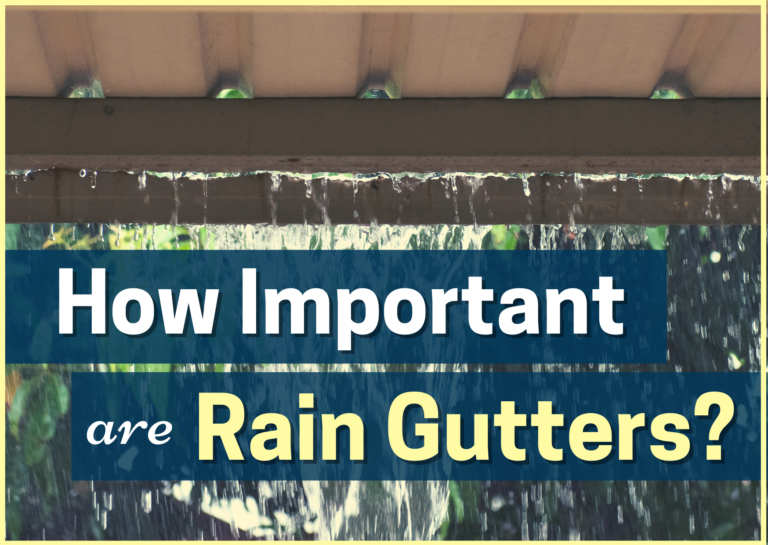Rain gutter are the outdoor plumbing of a house. Rain gutters are designed to efficiently and quickly gets rid of rainwater to avoid flooding the property and protect the foundation. Leaves, roofing sand, and all other unwanted particles can easily accumulate on the roof, regardless of the weather, eventually sliding down with the rain, causing gutters to stop up. If you have open gutters near trees, you should clean the gutters out at least once a year. It is a good idea to have your rain gutters empty away from your house. If your rain gutters empty up hill, you are just going to have water run back towards the house. Landscape matters! Gutter crews are there to place gutters on the house, along with downspouts that empty in one direction or the other just above the ground. Placing ground extensions may not fall under the gutter install contract, and may be more along the lines of landscaping, not gutters.
Rain Gutters
A rain gutter is a small trough that can collect flowing water from the roof and directs the rainwater away from the foundation of the property to avoid possible damage to its foundation, keeping water from pooling under the house. This rainwater can be gathered in a storage tank that can be utilized for several purposes like watering the plants. There are several types and styles for rain gutters that can perfectly match the house’s design.
When effectively collecting and redirecting water, the gutter system has to have the right gutter capacity. Professional gutter installers will offer six inch K style aluminum gutters for the most part, being that this style is in demand. It is the biggest size offered for houses. There is a seven inch gutter, but these are mainly for commercial application. There is also five inch K style gutters you can find mostly on houses that have been around for a minuet. Of course there are half round, and different materials to choose from depending on customers taste.
Why Are Rain Gutters Important?
Several instances prove that a reliable gutter system is vital to every property, specifically to its foundation.
The surrounding ground is slanted
If the property is built at the foot of a slope, water tends to gather around the foundation. Through the gutter system, that section of the house will guide the slanted side’s water flow.
Red clay
When water starts to flow to a foundation built on a ground rich in clay, the soil can become the pipeline that continuously brings water to the same area. The gutter system with a drainpipe and gutter line can send the water to a safer site away from the house.
Roofs with no overhang
A property with a roof very close to its wall can direct the water to flow very near its foundation. This scenario usually leads to massive and costly foundation issues. Successive rainstorms can cause the formation of ditches where it can accumulate water. This puddle found near the foundation will be absorbed by the soil and eventually lead to serious property damage.
Creates tidy aesthetics
Watermarks visible on the wall can significantly affect the appearance of the property. The dirt residue on the siding can sometimes become too stubborn to remove, leaving a permanent mark. This can also chip the paint off, leading to an expensive repaint job of the entire wall. Installing a gutter system can maintain the tidiness of the property.
Where Does The Rainwater From The Gutter Go?
Installing a gutter system is one thing; knowing where the gutter drains belong is another. The landscaping of the house matters a lot. Your gutter downspouts should drain downhill away from your house. If your ground runs back towards the house, it defeats the purpose of the gutters. You can add splash blocks, or underground extensions to take water out to a lower drainage level in your yard.
Gullies, sewers, and downpipes
Once the water flows out from the downpipe, it will take the natural easiest rout to possibly road drainage, or just nature, depending on your house location and the rules of your surrounding community, or HOA possibly.
There are some older properties and houses created in remote locations that have private surface water systems. Their rainwater is gathered through the gutter, then carried to the downpipe, leading to a gully, and usually ends up in a creek.
What is the role of downspouts in a gutter system?
Downspouts are as crucial as gutters in protecting the property from potential water damage. This long vertical, tube-like device is attached to the gutter so the water can easily flow away from the property.
Protect the basement from getting flooded
Homeowners may consider it as their worst nightmare when they see a flooded basement. With the help of downspouts, it can considerably lower the risk of experiencing such a terrible scenario during successive rainstorms.
Protect wood or stone-based siding
If a property’s siding is made up of wood or stone, with intense water flow from the gutter, broken downspouts can cause mold formation and leave traces of filthy water. If this leak isn’t fixed and heavy rainfalls continue to occur, it will eventually weaken the siding and develop into cracks.
What are gutter guards, and why are they necessary?
Fallen leaves can be harmless until they accumulate and get stuck in the rain gutters. Some homeowners pay individuals to remove them, while others choose to be practical and do it independently. But there is another way, which is much simpler, less expensive, and more effective–install gutter guards. Be careful where you buy your gutter guards-covers, being that quality and pricing will vary wildly!
A gutter guard can be a cover placed on top of the gutters, which has mesh-like screen normally made from stainless steel, filtering the dirt, leaves, and other debris from the water. This cover primarily protects the gutter’s entrance from getting clogged from all sorts of particles and allows the water to seamlessly run through the pipe.
Gutter covers are made in various materials, which include plastic, nylon, and metal. They also come in multiple styles, and in every design, it has certain benefits in different weather patterns. Cleaning the gutters is imperative and must be done one or two times a year unless you have no trees close above the roof. But with these guards installed on the gutters, the cleaning process will be a lot easier and faster. Even if there is still a build-up of gunk, specks of dust, and bits, installing these covers will have a huge difference. Regardless if the covers are a bit dirty, it keeps the inside gutters flowing properly, ( If you pick the correct cover for your needs. )
Different houses have different needs for their gutter covers. You need to take into account what trees are growing near your house. Do you have big leaves, small leaves, pine needles, or seeds? Maybe you have something heavy like nuts? Some of these gutter covers will not take any weight. You do get what you pay for in this case. Do your research on the subject before jumping in on the next best thing.
Also, some high-altitude homes and cabins may notice that snow can quickly fill the gutter during winter and begin to press against the shingles. This causes moisture under the shingles and may damage the underlayment. The covers have designs that allow snow to slip off rather than accumulating in the gutters quickly. You can find ice melt setups for these extreme weather areas.
In my opinion as a gutter, and gutter cover installer, I would not buy anything plastic, because plastic will warp in the sun causing gaps, along with them being a bit flimsy under any weight, causing them to cave in on themselves followed by the leaves and seeds, making for a nice gutter garden. If you have pine needles, you need something with a finer screen, because the needles will stand straight up if the holes in the screen will allow. The problem with finer screen is, in the corners where the water has a heavy flow, the water can shoot off at times in heavy rains.
If you do not have pine needles, a little bigger hole screen is fine. You may want a screen that is not just flat, as to slow the rain flow, as the rain runoff crosses over the screen, slowing down the flow enough for the rain water to soak in before shooting off the gutter top. So what do you need for your house? You will hear some people that possibly had a bad experience with covers of some sort say, covers don’t work! Well, covers work fine if you pick the right covers and maintain them. Having covers will not be a fix all, but the right covers, are a vast improvement over just open gutters that clog and don’t work at all.
RELATED:
How Important Are Rain Gutters?
Leaking Gutter Repair


